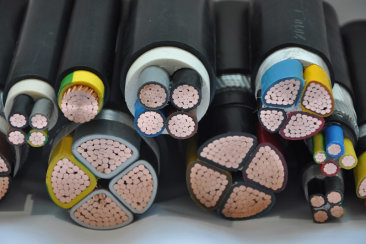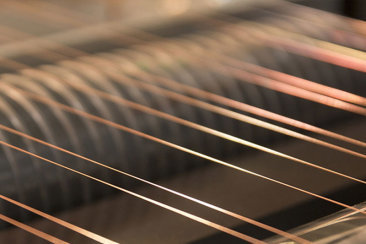Most cables on the market are made of copper core, what are the advantages of copper
Release time:
2023-11-17
Nowadays, cables have been used in industry. All aspects of production and life, including railways, ports, smelting, communication, and multiple industries, have rapidly developed with the help of cable technology. The current situation in the cable industry is that copper has better conductivity and thermal conductivity than aluminum, and wires and cables often use copper as a conductor. Currently, 97% of cables on the market are made of copper. Nowadays, the demand for cables in various industries is increasing, with an annual total output value of 1.2 trillion yuan, which consumes nearly 50% of China's copper resources, and 60% of copper resources are imported each year. Why can copper occupy such a large share of cable conductors? What are the advantages of copper cores compared to other metals? The most important points to count copper cores are as follows: copper has a low electrical resistivity, so let's compare it with another commonly used metal aluminum in cable conductors. The electrical resistivity of aluminum cables is about 1.68 times that of copper cables; The ductility of copper is also better than that of aluminum. Generally, the ductility of copper used for electrical purposes is over 30%, while aluminum is only 18%; Copper is more fatigue resistant, aluminum is prone to cracking during use, while copper has better elasticity and is less prone to fracture; Copper also has stronger corrosion resistance than aluminum; In terms of oxidation resistance, copper is also more stable than aluminum. In actual processes, copper core cables obviously have a longer lifespan, are more durable, and have more stable performance than aluminum core cables. That's why copper can occupy such a large proportion of cable conductors. However, replacing aluminum with copper is currently the main direction for the development of the entire cable industry. On the one hand, the high international copper prices have made the cost of cable related industries too high. In order to reduce costs, the cable industry has begun to develop research on replacing copper with aluminum. China is an active participant and researcher in the aluminum replacing copper plan, and has already achieved remarkable results in rare earth aluminum alloy cables. This is due to national strategic considerations, As the largest cable manufacturing country today, China needs to purchase a large amount of copper from abroad every year. In order to break away from this serious import dependence, the development of aluminum alloy cables is also imperative. In recent years, China has begun to explore rare earth aluminum alloy cables and has achieved good results. The independently developed rare earth high iron aluminum alloy conductor with independent intellectual property rights in China can replace copper cables in the market. Compared with copper cables, it has no inferior conductivity and flexibility, and its comprehensive usage cost is 40% lower than copper cables. Due to the relative abundance of aluminum metal compared to copper resources, aluminum has good advantages in both reducing cable costs and providing sufficient resources. Aluminum alloy cables are also considered the major direction for future cable development.

Nowadays, cables have been used in industry. All aspects of production and life, including railways, ports, smelting, communication, and multiple industries, have rapidly developed with the help of cable technology. The current situation in the cable industry is that copper has better conductivity and thermal conductivity than aluminum, and wires and cables often use copper as a conductor. Currently, 97% of cables on the market are made of copper. Nowadays, the demand for cables in various industries is increasing, with an annual total output value of 1.2 trillion yuan, which consumes nearly 50% of China's copper resources, and 60% of copper resources are imported each year.
Why can copper occupy such a large share of cable conductors? What are the advantages of copper cores compared to other metals? The most important points to count copper cores are as follows: copper has a low electrical resistivity, so let's compare it with another commonly used metal aluminum in cable conductors. The electrical resistivity of aluminum cables is about 1.68 times that of copper cables; The ductility of copper is also better than that of aluminum. Generally, the ductility of copper used for electrical purposes is over 30%, while aluminum is only 18%; Copper is more fatigue resistant, aluminum is prone to cracking during use, while copper has better elasticity and is less prone to fracture; Copper also has stronger corrosion resistance than aluminum; In terms of oxidation resistance, copper is also more stable than aluminum. In actual processes, copper core cables obviously have a longer lifespan, are more durable, and have more stable performance than aluminum core cables. That's why copper can occupy such a large proportion of cable conductors.
However, replacing aluminum with copper is currently the main direction for the development of the entire cable industry. On the one hand, the high international copper prices have made the cost of cable related industries too high. In order to reduce costs, the cable industry has begun to develop research on replacing copper with aluminum. China is an active participant and researcher in the aluminum replacing copper plan, and has already achieved remarkable results in rare earth aluminum alloy cables. This is due to national strategic considerations, As the largest cable manufacturing country today, China needs to purchase a large amount of copper from abroad every year. In order to break away from this serious import dependence, the development of aluminum alloy cables is also imperative.
In recent years, China has begun to explore rare earth aluminum alloy cables and has achieved good results. The independently developed rare earth high iron aluminum alloy conductor with independent intellectual property rights in China can replace copper cables in the market. Compared with copper cables, it has no inferior conductivity and flexibility, and its comprehensive usage cost is 40% lower than copper cables. Due to the relative abundance of aluminum metal compared to copper resources, aluminum has good advantages in both reducing cable costs and providing sufficient resources. Aluminum alloy cables are also considered the major direction for future cable development.
Previous article






